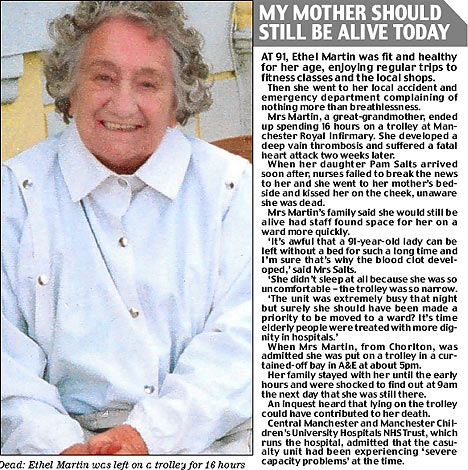
As many as 90,000 patient deaths a year could be linked to hospital errors, according to a study published today.
One in 10 NHS patients is harmed while in hospital and up to half of all blunders could be avoided, researchers found.
Of those who are harmed, around one in 10 errors may have contributed to the patient's death.
The alarming rate of 'adverse events' is revealed in a study of patients admitted to a large teaching hospital in the North of England.
Nationally, it could mean that 900,000 patients going into hospital each year end up damaged from errors including injury, infection, poor diagnosis and inadequate care.
Among the problems identified are:
• hospital acquired infections such as MRSA;
• complications during or after surgery;
• wrong diagnoses;
• pressure ulcers;
• drug complications;
• falls;
• unplanned transfers to operating theatre and intensive care;
• unplanned readmissions.
Scroll down for more...

The errors may contribute to as many as 90,000 deaths nationally and a similar number of cases of permanent disability.
The cost to the NHS has been estimated at more than £2billion in extra 'bed days'.
Professor Trevor Sheldon, of York University's department of health sciences, said other research showed a 10 per cent error rate in hospitals across
the developed world.
He said: "This does not make it acceptable, but suggests it isn't peculiar to the NHS.
"It may have something to do with the complexity and speed of modern hospital care but we don't just want more health care - we want better and safer care."
Researchers reviewed the notes of 1,006 patients admitted to the unnamed hospital between January and May 2004 and found between eight per cent and 10 per cent were harmed because of the care they received.
Between a third and a half of the incidents could have been prevented, they report in the journal Quality and Safety in Health Care.
Patients undergoing surgery were most likely to be harmed but other problems included falls, burns and complications leading to heart attacks.
More than half (56 per cent) of the incidents caused injury that lasted up to four weeks.
Another 17 per cent left patients disabled for up to six months, four per cent caused disability for six to 12 months and another 11 per cent caused permanent disability.
A further one in 10 errors contributed to the patient's death.
Such 'adverse events' meant patients had to stay in hospital for an extra 896 days in total, or eight days on average per patient.
Surgical patients were more likely to come to harm, but these incidents were less preventable, the study found.
Diagnostic errors, on the other hand, were less common, but could be more easily prevented.
Errors included a patient suffering rupturing of the gullet because the wrong size dilation balloon was used in a procedure.
Another experienced an avoidable delay in the diagnosis of a malignant condition, while another patient developed deep vein thrombosis and a blood clot in the lungs.
One patient died because a surgical team failed to review them after admission, failed to call a consultant and offered inadequate treatment.
One patient had their spleen torn, requiring them to stay on antibiotics for life, and another became addicted to high- strength painkilling drugs after being put on a high dose for a long time.
At least six million operations are carried out in England each year.
Prof Sheldon said: "One of the most important things a hospital can do is give staff sufficient time to look at adverse events and reflect, with the aim of learning from them.
"We should not be in the business of blaming people but finding ways of minimising avoidable errors."
A spokesman for the Department of Health said: "As the study suggests, many adverse events could be avoided if lessons were properly learned and fed back into practice.
"We would encourage health care providers to consider the findings of this study and how it might be used to support their existing arrangements for patient safety."
http://www.dailymail.co.uk/pages/live/articles/news/news.html?in_article_id=497216&in_page_id=1770